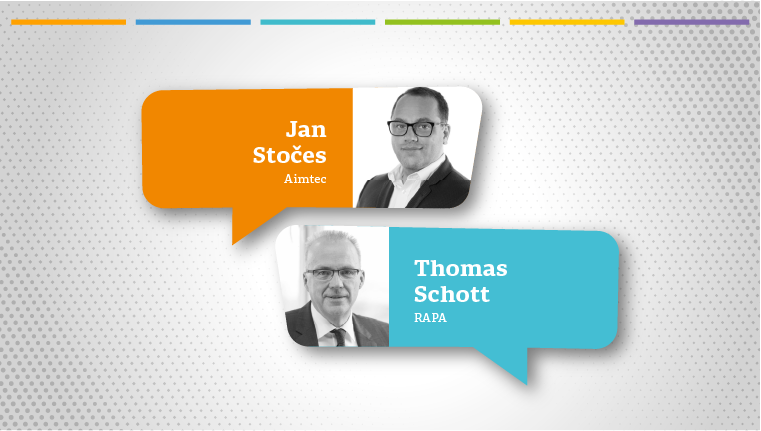EDI could be with us for the next 15 years, says RAPA's IT chief
- Automotive
- Interview
Thomas Schott has been responsible for IT at Rausch & Pausch (RAPA) for six years. However, he has been gaining experience in information technology for much longer. In the early 1990s, he was there when reputable suppliers in the automotive industry were beginning to implement electronic data interchange (EDI) systems. "This topic has been a constant presence in my professional life for thirty years," says the German manager.
As a supplier to the automotive industry, RAPA certainly uses EDI. And if we look at the evolution over recent years, how has the importance of EDI changed in your company over time?
The topic of EDI has definitely grown in importance in our company. In recent years we have managed to connect many new customers and suppliers, and the emphasis on EDI is becoming more and more apparent. We mainly use EDI in three areas: everything related to call-offs, logistics and invoice processes.
Looking at EDI as such, do you personally see any gaps that need to be filled?
Yes, we would like to see even more information in the interaction between the customer, the freight forwarder and the supplier, so that we can better track the goods received on our side, but also so that we can offer our customers the possibility to see in real time where our products are on their way to the OEM.
How do you think EDI will evolve in the future? What other opportunities do you see besides the improvements in forwarding that you just mentioned?
The potential of EDI plays an important role in the further digitisation of our business processes. We will see closer integration. Firstly, as has already been mentioned, on the transport logistics side, where we can see in real time where everything is, and secondly, it will be about integration between our suppliers, our customers and our production.
Can you give an example of an ideal scenario? And what would be the benefit of such a scenario?
In this case, our goal is an uninterrupted flow of information that includes the date of arrival, time window of arrival, time of handover, transportation, batches, packaging materials, simplified or automated receipt of goods. From the customer's point of view, it's about complete transparency as to when the goods will arrive.
For smaller suppliers, the most difficult part was to convert them to an EDI platform and make them "EDI ready".
Thomas Schott, IT Vice President, RAPA
Moving on to the cloud, what role does it play in relation to EDI in your company?
Without further expansion of cloud services, it will not be possible to take full advantage of EDI. The cloud will become a means for extensive and intensive networking with our partners.
A lot of data is exchanged via EDI. What potential do you see in this data, its evaluation, exploitation, etc.?
I believe we will get more information about shipping and shipping times because our factories are relatively far away from the OEM manufacturer. So I expect we will get more information and insight in the future.
What kind of information or data would you like to receive?
I see potential in the area of packaging material reservations, pooling or inventory, supplier-managed inventory, i.e., VMI functionalities such as picking notifications, stock information and EDI for payment transactions.
Do you think EDI will be retained or will it be replaced by another technology?
Given that EDI has been in use for more than 30 years, during which time there has been a real evolution of data formats in incremental steps, I believe it can continue to work this way for the next 10 to 15 years as current formats continue to evolve. The question is what Gaia-X will bring. I hope that it will give us the platform of the future, but based on past experience, I fear it will take many years before a significant number of customers and suppliers switch to it.
You also use EDI with your suppliers. How willing are they to implement EDI or communicate on the topic? And what has been the biggest obstacle in implementing EDI with suppliers?
For smaller suppliers, the most difficult part was to convert them to an EDI platform and make them "EDI ready". With suppliers who were already familiar with EDI, it was relatively easy to arrange, especially as we were able to implement it quickly, in a standardised way and with little testing, thanks to Aimtec.
You say that some of the suppliers did not use EDI. Have you considered introducing a webEDI platform or are you planning something like this in the future to connect even more suppliers electronically?
This is definitely an element that we will address, because I would like to manage the company from an IT perspective completely digitally, and part of this should be offering such a platform.
You have thus outlined one of the future projects. What else are you planning in the field of EDI?
In addition to the aforementioned topic of improving communication between us, our customers and the freight forwarder, we also want to work on the area of delivery to our customers so that we can give appropriate notice of deliveries.
Are you currently facing any problems when it comes to deliveries to customers? Do you have an idea of the ideal state or a specific goal you want to achieve in this area?
We strive for complete transparency in logistics, when what goods arrive, both goods to us and our products to our customers. As far as problems go, we are a little concerned that some customers are "misusing" EDI for unnecessary information. Here we need a global standard, and thus display of additional information via standard additional fields.
When it comes to EDI issues, what sources do you draw on to keep up to date with the latest developments, and where do you find inspiration for the future direction of your company from an IT perspective?
Mainly from Aimtec, but also in print or online media. Of course, I also go to congresses and hold debates with colleagues. But from Aimtec we regularly get a comprehensive overview of what is possible today and what will be possible tomorrow.
Are there topics that you follow or that inspire you? What is the current trend in your industry and why?
In the context of Industry 4.0, we see a big theme in providing measured data and test reports via EDI and linking our CAQ and ERP systems. Also, the introduction of a VMI process for the continuous exchange of stock, receiving and dispensing of materials to reduce the volume of stock on site and make it more readily available will help us to optimise transport logistics, thereby also reducing costs and CO2 emissions.
Do you want Error-free and effective communication with your customers and suppliers, just like at IAC Group? >> Take advantage of a non-binding consultation with an Aimtec expert!
Who is Thomas Schott?

In the 1990s, German IT manager Thomas Schott was there when renowned suppliers in the automotive industry started to introduce electronic data interchange (EDI) systems. Today, as responsible for the IT area at the supplier RAPA, he considers EDI to be an essential part of the automotive industry, which is also becoming even more important. Its aim is to improve RAPA's communication with both suppliers and customers, and also to make the entire logistics process completely transparent, so that all links in the supply chain can see where the material or product is. His key ally in this endeavour is the Czech company Aimtec, which specialises in the optimisation and digitalisation of processes in the automotive industry.
Read another expert interview. Find out what IAC is focusing on now and what EDI challenges they are facing.
Share article
Top stories from logistics, production and IT.
Subscribe to Aimtec Insights
By registering, you agree to the processing of your personal data by Aimtec as described in the Privacy policy.
Get top stories and articles
from Logistics, Production and IT.
Subscribe to Aimtec Insights
By registering, you agree to the processing of your personal data by Aimtec as described in the Privacy policy.








